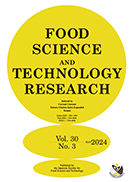Volume 30, Issue 3
Displaying 1-16 of 16 articles from this issue
- |<
- <
- 1
- >
- >|
Food Technology and Engineering
Original Papers
-
2024Volume 30Issue 3 Pages 269-280
Published: 2024
Released on J-STAGE: May 20, 2024
Advance online publication: March 04, 2024Download PDF (3068K) Full view HTML -
2024Volume 30Issue 3 Pages 281-294
Published: 2024
Released on J-STAGE: May 20, 2024
Advance online publication: March 01, 2024Download PDF (3863K) Full view HTML -
2024Volume 30Issue 3 Pages 295-303
Published: 2024
Released on J-STAGE: May 20, 2024
Advance online publication: March 12, 2024Download PDF (4278K) Full view HTML -
2024Volume 30Issue 3 Pages 305-311
Published: 2024
Released on J-STAGE: May 20, 2024
Advance online publication: March 06, 2024Download PDF (1430K) Full view HTML
Technical Paper
-
2024Volume 30Issue 3 Pages 313-321
Published: 2024
Released on J-STAGE: May 20, 2024
Advance online publication: February 15, 2024Download PDF (1553K) Full view HTML
Note
-
2024Volume 30Issue 3 Pages 323-330
Published: 2024
Released on J-STAGE: May 20, 2024
Advance online publication: February 27, 2024Download PDF (1750K) Full view HTML
Food Science and Chemistry
Original Paper
-
2024Volume 30Issue 3 Pages 331-341
Published: 2024
Released on J-STAGE: May 20, 2024
Advance online publication: January 19, 2024Download PDF (1939K) Full view HTML -
2024Volume 30Issue 3 Pages 343-352
Published: 2024
Released on J-STAGE: May 20, 2024
Advance online publication: January 23, 2024Download PDF (1334K) Full view HTML -
2024Volume 30Issue 3 Pages 353-365
Published: 2024
Released on J-STAGE: May 20, 2024
Advance online publication: February 13, 2024Download PDF (1885K) Full view HTML -
2024Volume 30Issue 3 Pages 367-376
Published: 2024
Released on J-STAGE: May 20, 2024
Advance online publication: January 22, 2024Download PDF (1454K) Full view HTML -
2024Volume 30Issue 3 Pages 377-385
Published: 2024
Released on J-STAGE: May 20, 2024
Advance online publication: February 14, 2024Download PDF (4988K) Full view HTML -
2024Volume 30Issue 3 Pages 387-396
Published: 2024
Released on J-STAGE: May 20, 2024
Advance online publication: February 02, 2024Download PDF (1421K) Full view HTML -
2024Volume 30Issue 3 Pages 397-408
Published: 2024
Released on J-STAGE: May 20, 2024
Advance online publication: February 28, 2024Download PDF (1972K) Full view HTML -
2024Volume 30Issue 3 Pages 409-417
Published: 2024
Released on J-STAGE: May 20, 2024
Advance online publication: March 11, 2024Download PDF (1756K) Full view HTML -
2024Volume 30Issue 3 Pages 419-430
Published: 2024
Released on J-STAGE: May 20, 2024
Advance online publication: March 21, 2024Download PDF (1795K) Full view HTML
Note
-
2024Volume 30Issue 3 Pages 431-438
Published: 2024
Released on J-STAGE: May 20, 2024
Advance online publication: February 29, 2024Download PDF (1827K) Full view HTML
- |<
- <
- 1
- >
- >|
